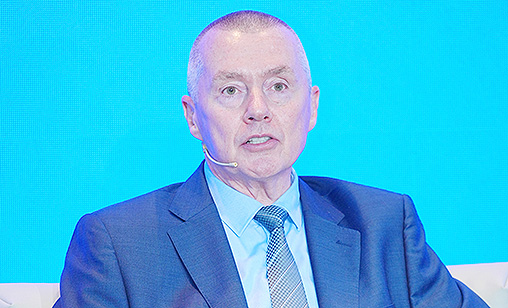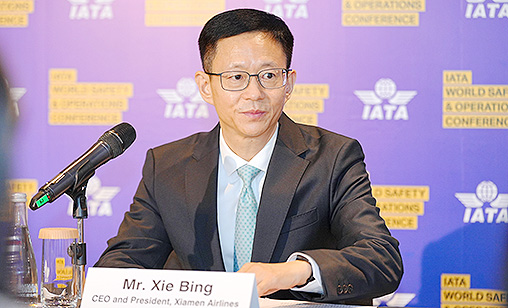Main Story
“We do not compete on safety”
October 1st 2025
The one sentence repeated most often at the International Air Transport Association (IATA) World Safety and Operations Conference (WSOC) in Xiamen in mid-October was: “We do not compete on safety, we cooperate on safety”. Read More »
IATA’s director general, Willie Walsh, said as much during the WSOC Opening Plenary and it was repeated countless times at workshops during the three days of the summit.
 |
And cooperating on safety, the delegates did. More than 45 hours of expert sessions on four tracks: Safety, Cabin, Flight Ops and Crisis Management provided an opportunity to learn, exchange knowledge and work on the solutions together.
The event was attended by 853 delegates from 70 countries, IATA said. As soon as the workshop sessions started, it became clear most attendees had arrived in Xiamen with a strong agenda to discuss the challenges and learn.
The level of preparation and discussion was very high. It was no surprise, given the scope of changes the aviation industry is faced with addressing.
“The environment in which airlines operate has grown even more complex as conflicts and regulatory fragmentation have proliferated. As a result, we have seen airspace closures, drone incursions and rising global navigation satellite system (GNNS) interference disrupt connectivity, undermine confidence, and threaten safety,” IATA global director safety, Mark Searle, said in his opening address.
IATA identified three critical priorities for aviation safety and operations: defending and evolving global standards, fostering a strong safety culture through leadership and using data to enhance performance amid growing operational challenges.
While the challenges to the safety environment might be worrying to the informed members of the general public, the WSOC should offer some reassurance - hundreds of safety experts working for airlines, OEMs and regulators are a step ahead in discussing the best working solutions to address these issues.
“A good example of this might be addressing the opportunities and challenges of harnessing the growing amount of available data.
“The fact that a single airplane can produce the same amount of data as an entire airline did in the 1990s,” as Atos chief growth officer, Clay van Doren, pointed out can be both an opportunity and a challenge.
 |
Some panelists in the Safety track believed more data can help, as it provides more information to make a decision. Others pointed out the risk of the “data lake” problem, in which a critical piece of information can be buried under an excessive amount of other figures.
The invited experts said both arguments are right and it is imperative airlines use the up-to-date tools are available, helping to navigate through the data.
Airbus Head Safety Enhancement, Ian Goodwin, highlighted the need to update how we view safety. “We need to be pragmatic not dogmatic,” he said, explaining there is no need to go 120% on safety, which can make the process much longer, when 100% will do.
It was generally agreed an important way to enhance safety is to exchange data with other stakeholders - airlines, OEMs, regulators and airport operators.
Several data-sharing programs are operated by IATA and the conference provided an opportunity to introduce them as well as to share the experience of the participating airlines.
One of the pressing issues discussed by the cabin operations experts was addressing the incidents with lithium-ion battery-powered products carried on board by passengers.
IATA unveiled ‘Travel Smart with Lithium Batteries’, a global safety campaign of seven simple rules for passengers carrying mobile phones, laptops, power banks and other lithium-powered devices safely onboard.
A Pixar Animation Studio-style video attempts to draw the attention of travelers and explain how to handle the lithium-ion batteries.
“The challenge is great. In the Asia-Pacific, more than 70% air travelers do not know they are carrying potentially high-risk products when they fly, a UL Standards & Engagement study, conducted in February to late March this year revealed after the Air Busan accident.
 |
The same study said thermal runaway incidents are trending upwards and have increased 15% from 2019, when the data collection started and 2024. Globally, Li-Ion battery incidents during flights happen on average twice a week. Nearly one in five incidents result in significant passenger disruption, including diverted landings, evacuation, or return to the gate.
The rise of artificial intelligence (AI) and machine learning was one of the important themes mentioned during the conference. Xiamen Airlines is one of the carriers using the technology.
The airline is building the AI talent pool, introducing AI to train pilots and using predictive maintenance as well for the optimization of flight operations.
“The AI is not just a tool, but a partner,” Xie Bing, CEO and President of Xiamen Airlines said, adding his company adopted a “3T” (talent, technology and transformation) policy for using the technology.
Widely discussed in the flight operations track was a presentation by Wang Ronghui, Deputy General Manager, Maintenance and Engineering at Xiamen Airlines, sharing firsthand experiences on the implementation of machine learning and AI algorithms in day-to-day aircraft operations. The presentations came at a time predictive maintenance is gaining importance as one of the channels that allows for easing the negative aspects of the current supply chain issues.
The attendees participating in the Crisis Management track saw IATA launching a revised Emergency Response Best Practices Handbook. For the first time, it includes detailed guidance on family assistance.
“Accidents are rare. But when they happen, people are affected—not only those onboard but those waiting on the ground. Those who are impacted must feel supported, informed and respected. This new chapter will help the aviation industry meet those expectations in a timely and effective manner as documented in ICAO and IOSA standards,” said IATA’s Senior Vice President, Operations, Safety and Security, Nick Careen explaining the update.
Many delegates told Orient Aviation the event gave them the chance to learn about China’s industry achievements in digitalization and use of the new technologies, being named in the country as “smart aviation”. There was a strong representation of China’s industry experts in the workshops and discussion panels. Alongside the delegation of the host airline Xiamen Airlines, there were representatives of other Chinese state and commercial carriers, as well as a strong team from the state-owned Commercial Aircraft Corporation of China (COMAC). A highlight of the joint closing plenary ceremony was a presentation by Wu Guanghui, the chief scientist and chief designer of the COMAC Large Passenger Jet C919.
He detailed the decision process and challenges involved in developing the aircraft.
“We had a very good discussion, but let’s not just stop at it,” Searle said. “The risks in aviation will not magically disappear. If the previous years might provide any guidance, it is the industry needs to be ready for new challenges. Luckily for us all the rule “we do not compete on safety, we cooperate on safety”, means these challenges will not be faced alone. When the delegates meet at next year’s WSOC in Istanbul they will be more experienced and as always, ready to share their knowledge.”